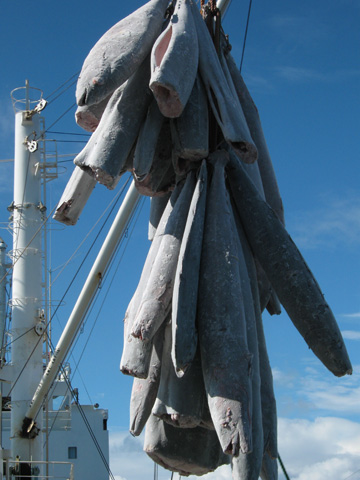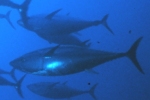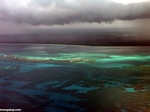The world’s oceans can no longer accommodate fisheries expansion, confirms a study conducted by joint effort between the University of British Columbia and the National Geographic Society. The study is the first of its kind to analyze the geographic expansion of global fisheries.
Published in the journal PLoS ONE, the study lends additional credence to reports that current fishing practices are unsustainable. Researchers holistically determined the ecological footprint of commercial fisheries by looking at primary production—the tiny organisms that make up the bottom of the food chain—and calculating the amount necessary to support current fishing yields around the world from 1950 to 2005. The study finds that the amount of primary production required to maintain commercial fishing at current levels far exceeds that which exists.
The study determined the ecological footprint through analysis of primary production because it allows for indirect comparisons between species. By regarding the entire ecosystem instead of focusing on a single species, this resulted in a better understanding of the “bigger picture”. The researchers then used this footprint to quantify the expansions of fisheries and reveal patterns.
 Around a half-ton of yellow-fin tuna, big-eye tuna, and marlin hauled in by a commercial fishery. |
“This method allows us to truly gauge the impact of catching all types of fish, from large predators such as bluefin tuna to small fish such as sardines and anchovies,” says Daniel Pauly, co-author and principal investigator of the Sea Around Us
Project at UBC Fisheries Centre. “Because not all fish are created equal and neither is their impact on the sustainability of our ocean.”
In 1950, most of ecological footprint of commercial fishing occurred only off the coasts of Europe, North America, and Japan. By 2005 it had expanded by about one degree of latitude per year to include most of the productive waters around the globe. The expansion resulted in a 500% increase in catch rates, from 19 million tons in 1950 to 87 million tons in 2005, resulting in an ecological footprint of 45 billion tons of primary productivity.
Fisheries expansion experienced its greatest rate of growth during the 1980s and 1990s. It reached a peak during the mid-1990s, after which expansion declined.
“The decline of spatial expansion since the mid-1990s is not a reflection of successful conservation efforts but rather an indication that we’ve simply run out of room to expand fisheries,” says Wilf Swartz, a PhD student at UBC Fisheries Centre and lead author of the study.
Fisheries have expanded to occupy most of the world’s productive waters, leaving only 0.1% designated as marine reserves. After 50 years of growth, global catches are now in marked decline. This study, along with many others, advises imposing stricter fishing regulations and quotas.
“The era of great expansion has come to an end, and maintaining the current supply of wild fish sustainably is not possible,” says co-author and National Geographic Ocean Fellow Enric Sala. “The sooner we come to grips with it—similar to how society has recognized the effects of climate change—the sooner we can stop the downward spiral by creating stricter fisheries regulations and more marine reserves.”
Related articles
Environmentalists: fishing quota could be death sentence for bluefin tuna

(11/28/2010) Once again, the International Commission for the Conservation of Atlantic Tuna (ICCAT) has flouted warnings from conservationists, evidence from scientists, and even recommendations from the European Commissioner Fisheries and Maritime Affairs in its most recent fishing quota for the Atlantic bluefin tuna. Meeting last week in Paris, ICCAT agreed to a 2011 fishing quota of 12,900 metric tons, 600 less than this year’s quota. Yet, environmentalists from a wide-range of organizations have been warning for years that without a moratorium on bluefin fishing—or at least a drastic reduction in quotas—the species is at risk of extinction. ICCAT’s own scientists say that the current quota gives the species a 70% chance of recovery.
World needs to protect 32 million square kilometers of ocean in two years
(10/20/2010) According to goals set in 2002 by the Convention on Biological Diversity (CBD) and the World Summit on Sustainable Development, nations must spend the next two years catching-up on creating ocean reserve. Currently, about 1.17 percent of the ocean is under some form of protection, but the 2002 goal was 10 percent by 2012. That means protecting over 32.5 million square kilometers, of the ocean twice the size of Russia. According to a recent report, Global Ocean Protection by the Nature Conservancy, not only is the world failing on its goals to protect a significant portion of the ocean, it’s also failing to protect 10 percent of various marine ecosystems.
Marine managed areas help reverse declining fisheries, create sustainable livelihoods
(09/16/2010) Marine managed areas in developing countries can help reverse declining fisheries while generating long-term benefits for communities, according to a series of reports released by Conservation International (CI). The reports, informed by more than 50 studies and 100 scientists in 23 countries around the world since 2005, evaluate the role of marine managed areas (MMAs) in maintaining ocean health, assess the link between sustainable ocean use and human well-being, and architect what it takes to successfully implement MMAs.
